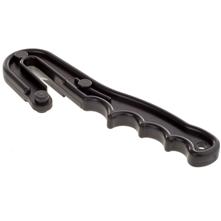beester
Contributor
A couple of days ago during a wreckdive on a North Sea wreck both me and my buddy got entangled, this has for obvious reasons shaken me a bit and I would like to share.
The context is as follows: I'm a intermediate diver with about 180 dives (all kinds of circumstances, cold, low vis, deep, current, etc). An experienced wreck diver asked me along with his group to do wreckdives stating that I would love it. (which I do).
The incident happened on my 6th wreck dive.
This was a wreck with a max depth of 110 feet. We were diving nitrox 32 on dual (Y) valved 119 HP tanks. Plan was to call the dive when hitting 60 bar or getting within 2 min of NDL. (if we plan on deco dive we obviously would plan more conservative). Make a free ascend to 45 feet, blow SMB and make our way up to 15 feet for a 5 min safety stop before finaly ascending.
What happend was the following. We descended along the buoy line to a depth of 110 feet on the wreck... vis was not bad (around 20 feet). We started enjoying the wreck occationally looking into holes for bugs or cod (but without entering any overhead environments). When we were about to call the dive after 30+ minutes on the wreck my buddy got caught in monofillament netting. I turned to him to aid him and was caught too.
At first we tried to swim loose slowly which was a mistake and made the situation worse... we stopped and we started to clean eachother off... cutting as many lines as possible (very hard to see). In the end we had to cut off the fins from my buddy in order to release us. When we finaly started ascending we had about 25 bar left (about 4 min worth of gas at that depth depending on anxiety it could have been 2). We came up to 40 feet (him without fins) shot our SMB and lined up to 15 feet and did our 5 min of safety stop. We came up with 10 bar of pressure.
Obviously we cut this too short. I'm still a bit shaken and have not yet analysed the shortcomings but anyway things I'll be looking at will be:
Pro:
- We didn't panick. If we had panicked bad **** could have happened.
- We worked quite well together under water... if we had been separated we would have had more issues.
- we managed to keep our composure and even with complications (my buddy without fins) we managed to ascend safely, deploy smb and do a safety stop after we got out of the netting.
Con:
- Gas management: We cut it too short. Of course the incident happened at the worst possible moment (close to return pressure) but still.
Anyway... have a go at me
The context is as follows: I'm a intermediate diver with about 180 dives (all kinds of circumstances, cold, low vis, deep, current, etc). An experienced wreck diver asked me along with his group to do wreckdives stating that I would love it. (which I do).
The incident happened on my 6th wreck dive.
This was a wreck with a max depth of 110 feet. We were diving nitrox 32 on dual (Y) valved 119 HP tanks. Plan was to call the dive when hitting 60 bar or getting within 2 min of NDL. (if we plan on deco dive we obviously would plan more conservative). Make a free ascend to 45 feet, blow SMB and make our way up to 15 feet for a 5 min safety stop before finaly ascending.
What happend was the following. We descended along the buoy line to a depth of 110 feet on the wreck... vis was not bad (around 20 feet). We started enjoying the wreck occationally looking into holes for bugs or cod (but without entering any overhead environments). When we were about to call the dive after 30+ minutes on the wreck my buddy got caught in monofillament netting. I turned to him to aid him and was caught too.
At first we tried to swim loose slowly which was a mistake and made the situation worse... we stopped and we started to clean eachother off... cutting as many lines as possible (very hard to see). In the end we had to cut off the fins from my buddy in order to release us. When we finaly started ascending we had about 25 bar left (about 4 min worth of gas at that depth depending on anxiety it could have been 2). We came up to 40 feet (him without fins) shot our SMB and lined up to 15 feet and did our 5 min of safety stop. We came up with 10 bar of pressure.
Obviously we cut this too short. I'm still a bit shaken and have not yet analysed the shortcomings but anyway things I'll be looking at will be:
Pro:
- We didn't panick. If we had panicked bad **** could have happened.
- We worked quite well together under water... if we had been separated we would have had more issues.
- we managed to keep our composure and even with complications (my buddy without fins) we managed to ascend safely, deploy smb and do a safety stop after we got out of the netting.
Con:
- Gas management: We cut it too short. Of course the incident happened at the worst possible moment (close to return pressure) but still.
Anyway... have a go at me






